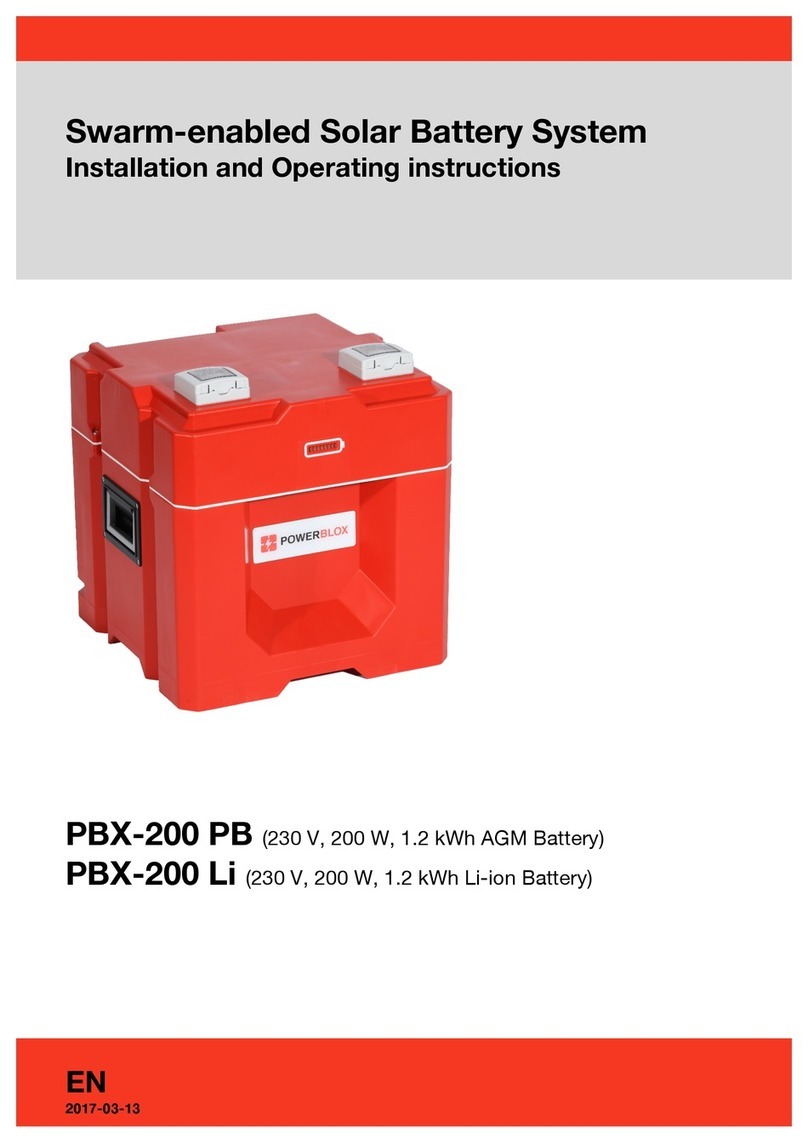
Installation and Operating Instructions PBX-200 Pb ; Li ; Li/LE Page 2
Table of contents
1INTRODUCTION AND GENERAL................................................................................................................... 4
1.1 FOREWORD .......................................................................................................................................................4
1.2 CONTACT DETAILS...............................................................................................................................................5
1.3 EXPLANATION OF SYMBOLS...................................................................................................................................5
1.4 GENERAL SAFETY INSTRUCTIONS ...........................................................................................................................5
2SCOPE OF DELIVERY, TRANSPORT AND STORAGE........................................................................................ 7
2.1 AVAILABLE VERSIONS...........................................................................................................................................7
2.2 SCOPE OF DELIVERY.............................................................................................................................................7
2.3 STORAGE AND TRANSPORT ...................................................................................................................................7
3OVERVIEW OF THE PBX-200 ....................................................................................................................... 8
4PROPERTIES AND TECHNICAL DATA...........................................................................................................11
4.1 PBX-200 PICTORIAL SCHEMATIC .........................................................................................................................14
5SAFETY AND ACCIDENT PREVENTION.........................................................................................................15
5.1 PERSONNEL .....................................................................................................................................................15
5.2 PROTECTION AGAINST ELECTRIC SHOCK.................................................................................................................15
5.3 INFORMATION ABOUT THE BATTERIES...................................................................................................................16
5.3.1 Approved battery types............................................................................................................................16
5.3.2 Protective equipment...............................................................................................................................17
5.3.3 Potential hazards of AGM lead-acid batteries (PBX-200 Pb)...................................................................17
5.3.4 First aid measures for AGM lead acid batteries (PBX-200 Pb).................................................................18
5.3.5 Measures in case of accidental release of lead acid................................................................................18
5.3.6 Potential hazards of LiFePO4 batteries (PBX-200 Li) ...............................................................................18
5.3.7 First aid measures for LiFePO4 batteries Electrolyte (PBX-200 Li)...........................................................18
5.3.8 Measures in case of accidental release of LiFePO4 batteries Electrolyte ................................................19
5.4 IN CASE OF FIRE ................................................................................................................................................19
5.4.1 General notes...........................................................................................................................................19
5.4.2 Fire fighting measures for AGM lead-acid batteries (PBX-200 Pb)..........................................................19
5.4.3 Fire fighting measures for LiFePO4 batteries (PBX-200 Li) ......................................................................19
6INSTALLATION AND COMMISSIONING.......................................................................................................20
6.1 GENERAL.........................................................................................................................................................20
6.2 SITE CONDITIONS ..............................................................................................................................................21
6.3 CONNECTING THE SOLAR MODULE TO THE PBX-200 ..............................................................................................22
6.3.1 Plug mounting of the solar connection....................................................................................................23
6.4 COUPLING OF PBX-200.....................................................................................................................................24
6.5 MINIMUM DISTANCES .......................................................................................................................................26
6.6 INTERCONNECTING SEVERAL TOWERS TO FORM A "POWER WALL"............................................................................27
6.7 USE OF THE CONNECTION TERMINALS...................................................................................................................27
6.7.1 Connecting the terminal cables ...............................................................................................................29
6.8 INTERCONNECTION TYPES...................................................................................................................................30
6.8.1 Solar-powered PBX-200 ...........................................................................................................................31
6.8.2 Solar and network operated PBX-200......................................................................................................31
6.8.3 Backup system .........................................................................................................................................32
6.8.4 Combined solar / grid system with connection to the terminal blocks....................................................32
6.9 INSTALL PBX-200.............................................................................................................................................33
6.9.1 Installation of a single PBX-200 ...............................................................................................................33
6.9.2 Installation of additional PBX-200s to a tower or Power Wall (maximum 9 units).................................33
6.9.3 Installation of power systems larger than nine PBX-200.........................................................................34
7OPERATION ..............................................................................................................................................35
7.1 IMPORTANT NOTES BEFORE COMMISSIONING ........................................................................................................35
7.2 LED DISPLAY ....................................................................................................................................................35




























